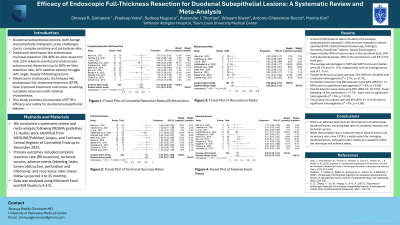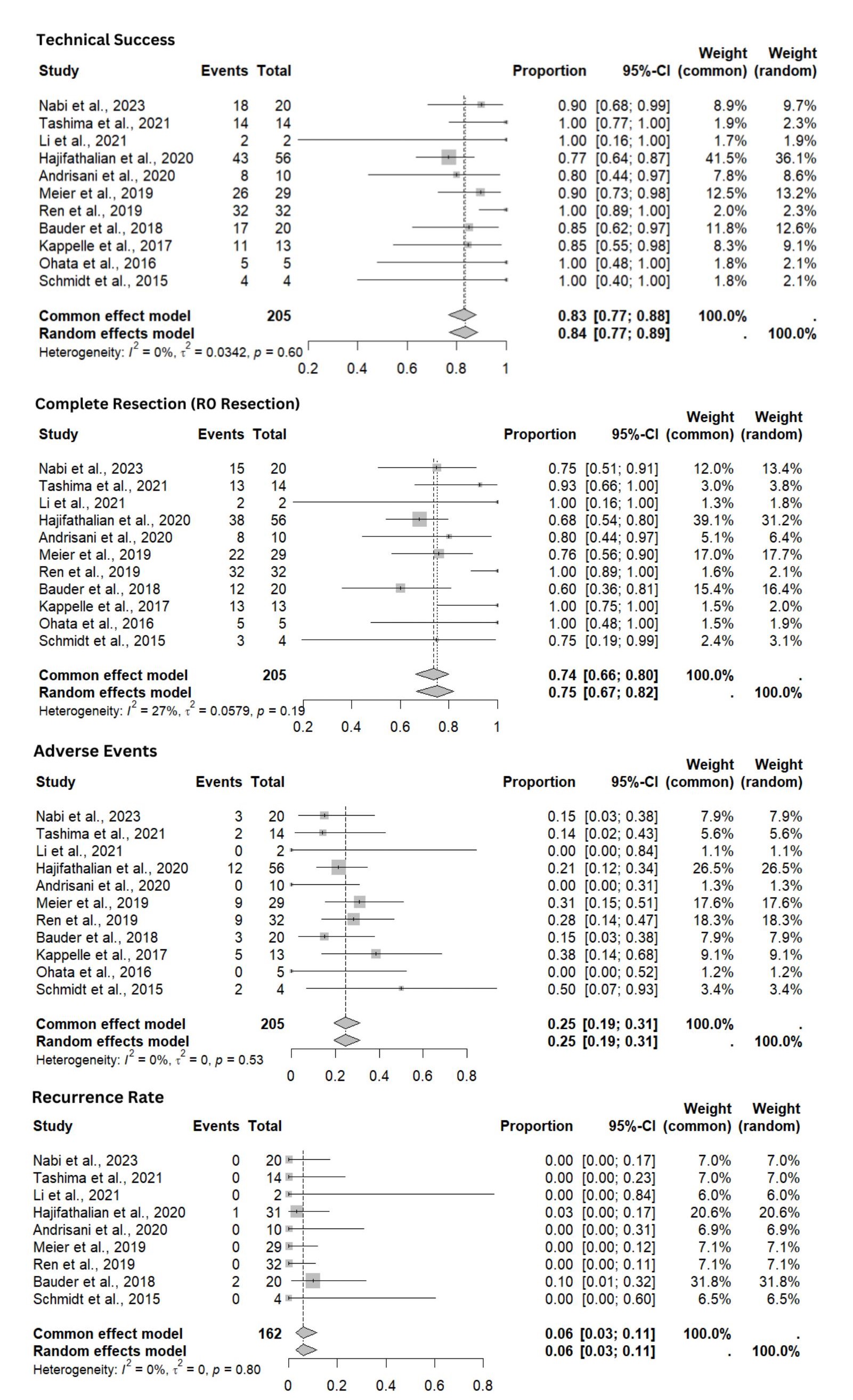Monday Poster Session
Category: Interventional Endoscopy
P2758 - Efficacy of Endoscopic Full-Thickness Resection for Duodenal Subepithelial Lesions: A Systematic Review and Meta-Analysis
Monday, October 28, 2024
10:30 AM - 4:00 PM ET
Location: Exhibit Hall E

Has Audio

Shravya Ginnaram, MD
Jefferson Abington Hospital
Willow Grove, PA
Presenting Author(s)
Shravya Ginnaram, MD1, Pradeep Yarra, MD2, Sudeep Nugooru, MD, MBA1, Alexander J. Thomas, MD3, Wissam Kiwan, MD4, Antonio R. Cheesman, MD3, Marina Kim, MD3
1Jefferson Abington Hospital, Willow Grove, PA; 2Saint Louis University School of Medicine, St. Louis, MO; 3SSM Health Saint Louis University Hospital, St. Louis, MO; 4Saint Louis University, St. Louis, MO
Introduction: Duodenal subepithelial lesions, both benign and potentially malignant, pose challenges due to complex anatomy and procedure risks. Traditional techniques like endoscopic mucosal resection (30-40% en-bloc resection rate, 22% adverse events) and endoscopic submucosal dissection (up to 80% en-bloc resection rate, 20% adverse events) struggle with larger, deeply infiltrating lesions. Advances in endoscopic techniques like endoscopic full-thickness resection (EFTR) have improved treatment outcomes, enabling complete resection with minimal invasiveness. This study provides an overview of EFTR’s efficacy and safety for duodenal subepithelial lesions.
Methods: We conducted a systematic review and meta-analysis following PRISMA guidelines. 11 studies were identified from MEDLINE/PubMed, Scopus, and Cochrane Central Register of Controlled Trials up to December 2023. Primary outcomes included complete resection rate (R0 resection), technical success, adverse events (bleeding, leaks, lumen obstruction, perforation and infections), and recurrence rates (mean follow up period 3 to 35 months). Data was analyzed using Microsoft Excel and R/R Studio (v 4.4.0).
Results: A total of 318 patients were included in the analysis, evaluating both exposed (~18%) and non-exposed or device-assisted EFTR (~82%) (Ovesco Endoscopy, Tübingen, Germany; OverStitch™ system, Apollo Endosurgery).
Approximately 40% of lesions were in the duodenal bulb, 25% in the duodenal sweep, 30% in the second part, and 5% in the third part. The average percentages for NET and GIST across all studies were 26.1% and 21.11%, respectively, with an average lesion size of 1.7 cm.
The pooled technical success rate was 74% (95% CI: 66-80%) with moderate heterogeneity (I² = 27%, p = 0.19). The complete resection rate (R0 resection) was 83% (95% CI: 77-88%) with no significant heterogeneity (I² = 0%, p = 0.60). Pooled adverse event rates were 25% (95% CI: 19-31%): major bleeding ~4.4%, perforation ~17.7% - both with no significant heterogeneity (I² = 0%, p = 0.53). The pooled recurrence rate was 6% (95% CI: 3-11%) with no significant heterogeneity (I² = 0%, p = 0.80).
Discussion: EFTR is an effective technique for the treatment of submucosal duodenal lesions, achieving high rates of complete resection and technical success. While the procedure has a moderate rate of adverse events, the recurrence rate is low. EFTR is a viable option for managing duodenal lesions, although further studies are needed to refine the technique and enhance safety.

Disclosures:
Shravya Ginnaram, MD1, Pradeep Yarra, MD2, Sudeep Nugooru, MD, MBA1, Alexander J. Thomas, MD3, Wissam Kiwan, MD4, Antonio R. Cheesman, MD3, Marina Kim, MD3. P2758 - Efficacy of Endoscopic Full-Thickness Resection for Duodenal Subepithelial Lesions: A Systematic Review and Meta-Analysis, ACG 2024 Annual Scientific Meeting Abstracts. Philadelphia, PA: American College of Gastroenterology.
1Jefferson Abington Hospital, Willow Grove, PA; 2Saint Louis University School of Medicine, St. Louis, MO; 3SSM Health Saint Louis University Hospital, St. Louis, MO; 4Saint Louis University, St. Louis, MO
Introduction: Duodenal subepithelial lesions, both benign and potentially malignant, pose challenges due to complex anatomy and procedure risks. Traditional techniques like endoscopic mucosal resection (30-40% en-bloc resection rate, 22% adverse events) and endoscopic submucosal dissection (up to 80% en-bloc resection rate, 20% adverse events) struggle with larger, deeply infiltrating lesions. Advances in endoscopic techniques like endoscopic full-thickness resection (EFTR) have improved treatment outcomes, enabling complete resection with minimal invasiveness. This study provides an overview of EFTR’s efficacy and safety for duodenal subepithelial lesions.
Methods: We conducted a systematic review and meta-analysis following PRISMA guidelines. 11 studies were identified from MEDLINE/PubMed, Scopus, and Cochrane Central Register of Controlled Trials up to December 2023. Primary outcomes included complete resection rate (R0 resection), technical success, adverse events (bleeding, leaks, lumen obstruction, perforation and infections), and recurrence rates (mean follow up period 3 to 35 months). Data was analyzed using Microsoft Excel and R/R Studio (v 4.4.0).
Results: A total of 318 patients were included in the analysis, evaluating both exposed (~18%) and non-exposed or device-assisted EFTR (~82%) (Ovesco Endoscopy, Tübingen, Germany; OverStitch™ system, Apollo Endosurgery).
Approximately 40% of lesions were in the duodenal bulb, 25% in the duodenal sweep, 30% in the second part, and 5% in the third part. The average percentages for NET and GIST across all studies were 26.1% and 21.11%, respectively, with an average lesion size of 1.7 cm.
The pooled technical success rate was 74% (95% CI: 66-80%) with moderate heterogeneity (I² = 27%, p = 0.19). The complete resection rate (R0 resection) was 83% (95% CI: 77-88%) with no significant heterogeneity (I² = 0%, p = 0.60). Pooled adverse event rates were 25% (95% CI: 19-31%): major bleeding ~4.4%, perforation ~17.7% - both with no significant heterogeneity (I² = 0%, p = 0.53). The pooled recurrence rate was 6% (95% CI: 3-11%) with no significant heterogeneity (I² = 0%, p = 0.80).
Discussion: EFTR is an effective technique for the treatment of submucosal duodenal lesions, achieving high rates of complete resection and technical success. While the procedure has a moderate rate of adverse events, the recurrence rate is low. EFTR is a viable option for managing duodenal lesions, although further studies are needed to refine the technique and enhance safety.

Figure: Forest Plot Comparing Outcomes of Endoscopic Full Thickness Resection (EFTR) for the Treatment of Duodenal Subepithelial Lesions
Disclosures:
Shravya Ginnaram indicated no relevant financial relationships.
Pradeep Yarra indicated no relevant financial relationships.
Sudeep Nugooru indicated no relevant financial relationships.
Alexander Thomas indicated no relevant financial relationships.
Wissam Kiwan indicated no relevant financial relationships.
Antonio Cheesman indicated no relevant financial relationships.
Marina Kim indicated no relevant financial relationships.
Shravya Ginnaram, MD1, Pradeep Yarra, MD2, Sudeep Nugooru, MD, MBA1, Alexander J. Thomas, MD3, Wissam Kiwan, MD4, Antonio R. Cheesman, MD3, Marina Kim, MD3. P2758 - Efficacy of Endoscopic Full-Thickness Resection for Duodenal Subepithelial Lesions: A Systematic Review and Meta-Analysis, ACG 2024 Annual Scientific Meeting Abstracts. Philadelphia, PA: American College of Gastroenterology.

